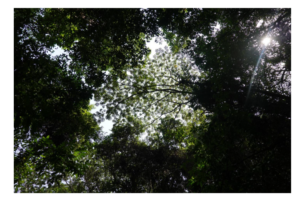Fractional absorbed photosynthetic radiation, and photosynthetic traits are responsible for widespread underestimation of West African forests productivity.  Photo Credit: Huanyuan Zhang-Zheng. One of the study site: Ankasa forest reserve
Photo Credit: Huanyuan Zhang-Zheng. One of the study site: Ankasa forest reserve
The Science
Tropical forests are some of the most important ecosystems on Earth, contributing a massive portion of the planet’s biomass and carbon absorption. They act as vital carbon sinks, absorbing CO₂ from the atmosphere and playing a crucial role in regulating the global climate. Accurate estimation of their productivity is vital for understanding how effectively they sequester carbon and how they might respond to changing environmental conditions. Historically, models have struggled to estimate tropical forest productivity accurately, particularly in West Africa.
The Impact
The study explores why current global models underestimate the Gross Primary Productivity (GPP)—the rate at which forests convert carbon dioxide into biomass through photosynthesis—of West African tropical forests. In short, the team led by Huanyuan discovered that these forests are more productive than previously thought, often outperforming even the Amazon in terms of carbon assimilation. Yet, existing models fail to capture this, underscoring the need for improved data inputs and modelling approaches.
Summary
This region’s GPP is often underestimated, with field measurements revealing far higher productivity than global models suggest. The reasons for this mismatch lie in the models’ inputs, particularly in terms of light use efficiency (LUE), the fraction of absorbed photosynthetically active radiation (fAPAR), and how local climate conditions are represented. The study focused on three sites in Ghana, representing the major forest types in West Africa: the Ankasa rainforest (ANK), the semi-deciduous Bobiri forest (BOB), and the dry Kogyae forest (KOG). Each of these sites revealed significant discrepancies between biometric GPP—measured directly in the field—and the GPP estimates from widely used global models like MODIS, FLUXCOM, and dynamic global vegetation models (DGVMs). On average, the models underestimated GPP by 56.3%, with the most significant discrepancies occurring at the semi-deciduous BOB site. Interestingly, this gap between field measurements and models narrowed when local data were incorporated into the models. For example, when a simple photosynthesis model (P-model, a new generation model led by Prof Colin Prentice) was adjusted to use field-measured inputs like photosynthetic traits and absorbed sunlight, its GPP estimates came closer to the real values, though small discrepancies remained in the wetter rainforest site at Ankasa.
Contact
Huanyuan Zhang-Zheng
University of Oxford
huanyuan.zhang@ouce.ox.ac.uk
Funding
The study was supported as part of the Next Generation Ecosystem Experiments-Tropics, funded by the U.S. Department of Energy, Office of Science, Office of Biological and Environmental Research. The author team also received funding from UK Natural Environment Research Council.
Publications
Zhang-Zheng, H., Deng, X., Aguirre-Gutiérrez, J. et al. Why models underestimate West African tropical forest primary productivity. Nat Commun 15, 9574 (2024). https://doi.org/10.1038/s41467-024-53949-0
Zhang-Zheng, H., Adu-Bredu, S., Duah-Gyamfi, A. et al. Contrasting carbon cycle along tropical forest aridity gradients in West Africa and Amazonia. Nat Commun 15, 3158 (2024). https://doi.org/10.1038/s41467-024-47202-x
Related Links
The conversation: https://theconversation.com/moo-deng-the-celebrated-hippos-real-home-has-disappeared-will-the-world-restore-it-241815
Los Angeles Times: https://www.latimes.com/world-nation/story/2024-11-25/moo-deng-baby-pygmy-hippo-thailand-social-media-celebrity